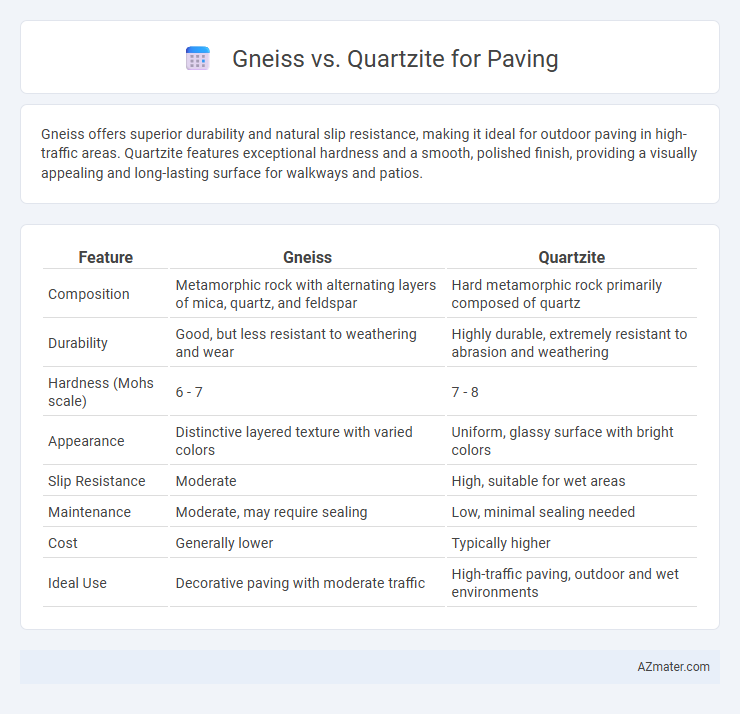Gneiss offers superior durability and natural slip resistance, making it ideal for outdoor paving in high-traffic areas. Quartzite features exceptional hardness and a smooth, polished finish, providing a visually appealing and long-lasting surface for walkways and patios.
Table of Comparison
| Feature | Gneiss | Quartzite |
|---|---|---|
| Composition | Metamorphic rock with alternating layers of mica, quartz, and feldspar | Hard metamorphic rock primarily composed of quartz |
| Durability | Good, but less resistant to weathering and wear | Highly durable, extremely resistant to abrasion and weathering |
| Hardness (Mohs scale) | 6 - 7 | 7 - 8 |
| Appearance | Distinctive layered texture with varied colors | Uniform, glassy surface with bright colors |
| Slip Resistance | Moderate | High, suitable for wet areas |
| Maintenance | Moderate, may require sealing | Low, minimal sealing needed |
| Cost | Generally lower | Typically higher |
| Ideal Use | Decorative paving with moderate traffic | High-traffic paving, outdoor and wet environments |
Introduction to Gneiss and Quartzite
Gneiss is a high-grade metamorphic rock characterized by its distinct banding and mineral composition, commonly used in paving for its durability and aesthetic appeal. Quartzite, formed from sandstone subjected to intense heat and pressure, features a hard, non-foliated texture ideal for heavy-duty paving applications. Both stones offer excellent weather resistance, but gneiss provides a more varied color palette while quartzite is favored for its hardness and slip resistance.
Formation and Geological Differences
Gneiss forms through high-grade regional metamorphism of pre-existing rocks, characterized by its distinct foliation and banded texture due to the re-alignment of minerals under intense pressure and temperature. Quartzite originates from the metamorphism of pure quartz sandstone, resulting in an interlocking crystalline texture that provides exceptional hardness and resistance. These geological differences influence their suitability for paving: gneiss offers a visually textured and durable surface, while quartzite delivers superior abrasion resistance and a smoother finish.
Physical Appearance and Color Variations
Gneiss exhibits a banded or foliated texture with alternating layers of light and dark minerals, creating a striking striped appearance ideal for decorative paving. Quartzite, composed primarily of quartz, has a more uniform, granular texture with a glassy or sugary luster, offering a sleek and consistent look. Color variations in gneiss typically include shades of gray, pink, white, and black, while quartzite ranges from white and gray to pink, red, and even blue hues, providing diverse aesthetic options for paving surfaces.
Hardness and Durability Comparison
Gneiss and quartzite are both exceptionally hard metamorphic rocks commonly used for paving, with quartzite typically rating around 7 on the Mohs hardness scale, making it harder than gneiss, which usually falls between 6 and 7. Quartzite's superior hardness contributes to its enhanced resistance to abrasion, impact, and weathering, making it more durable for high-traffic outdoor paving applications. Gneiss offers a good balance of hardness and aesthetic appeal with pronounced foliations but may show increased susceptibility to fracturing under heavy loads compared to the denser, interlocking quartz crystals in quartzite.
Slip Resistance and Surface Texture
Gneiss offers superior slip resistance compared to quartzite due to its foliated texture, providing natural grip ideal for outdoor paving. Quartzite, while harder and more durable, has a smoother surface that can become slippery when wet, requiring additional treatment for safe walkways. Both materials are suitable for paving, but gneiss is preferred in areas where traction and safety are critical.
Weathering and Maintenance Needs
Gneiss offers superior resistance to weathering due to its foliated, banded structure, making it highly durable for paving in varying climates. Quartzite, composed primarily of quartz, excels in hardness and resists chemical weathering, reducing maintenance frequency despite occasional surface erosion in acidic environments. Both stones require periodic sealing to maintain appearance and prevent water infiltration, but quartzite generally demands less maintenance due to its denser, more uniform composition.
Cost and Availability
Gneiss offers a more affordable option for paving due to its widespread availability and natural durability, making it suitable for budget-conscious projects. Quartzite, while generally more expensive, provides superior hardness and resistance to wear, often justifying the higher cost in high-traffic or decorative applications. Both materials are readily available in many regions, but local quarry sources and transportation costs can significantly impact the final price.
Installation Process
The installation process for gneiss and quartzite paving involves meticulous surface preparation and precise joint alignment to ensure durability and visual appeal. Gneiss typically requires careful handling due to its foliated texture, which may necessitate reinforced sub-base layers to prevent fracturing under load. Quartzite, valued for its hardness and resistance to abrasion, demands skilled cutting techniques and stable bedding materials to accommodate its dense, crystalline structure during installation.
Suitability for Different Paving Applications
Gneiss offers exceptional durability and slip resistance, making it highly suitable for outdoor pathways, driveways, and heavy-traffic areas where robust performance is essential. Quartzite's natural hardness and resistance to abrasion make it ideal for decorative paving, patios, and spaces requiring a polished, elegant finish while maintaining strength. Both stones withstand weather exposure well, but gneiss performs better under heavy loads, whereas quartzite excels in aesthetic appeal and smoother surfaces.
Environmental Considerations and Sustainability
Gneiss and quartzite are both durable natural stones suitable for paving, but quartzite typically has a lower environmental impact due to its higher density, which reduces the amount of stone needed for the same coverage. Quarrying quartzite often involves less energy consumption and generates less waste compared to gneiss, making it a more sustainable choice for eco-conscious projects. Both stones are recyclable and long-lasting, but quartzite's resistance to weathering enhances its sustainability by extending pavement lifespan and reducing maintenance frequency.

Infographic: Gneiss vs Quartzite for Paving
 azmater.com
azmater.com